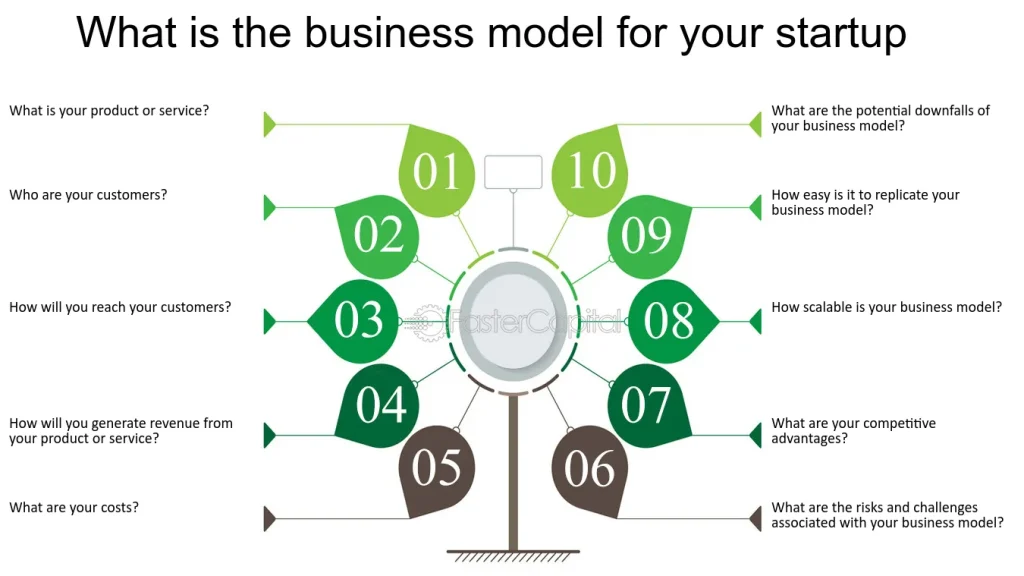Starting an internet business can be an exciting journey filled with endless possibilities. However, one of the most critical decisions you’ll make is choosing the right business model for your startup. The business model you select will not only determine how you generate revenue but also influence your product development, marketing strategies, and overall operations.
In today’s digital era, there are various business models that internet startups can adopt, each with its pros and cons. In this guide, we’ll explore the key factors to consider when choosing a business model and the most popular models that startups use to thrive in the online marketplace.
Table of Contents:
- Understanding the Importance of a Business Model
- Key Considerations Before Choosing a Business Model
- Popular Business Models for Internet Startups
- How to Test and Validate Your Business Model
- Case Studies of Successful Business Models
- Adapting Your Business Model for Long-Term Growth
- Conclusion

1. Understanding the Importance of a Business Model
A business model outlines how your startup will create, deliver, and capture value. In simpler terms, it’s the roadmap for how your business will make money.
Choosing the right business model is critical because:
- Revenue Generation: It determines how you will earn money, whether through subscriptions, direct sales, ads, or other streams.
- Customer Engagement: Different models affect how you engage with your target audience.
- Scalability: Some models offer better scalability than others, influencing long-term growth potential.
- Cost Structure: Your business model will dictate your operational costs, affecting profitability.
Ultimately, the right business model can lead to sustainability, profitability, and growth, while a poor choice can result in struggles to attract customers or generate enough revenue to cover costs.
2. Key Considerations Before Choosing a Business Model
Before diving into the most common internet business models, it’s essential to reflect on key factors that can influence your choice:
A. Understand Your Target Audience
Understanding who your customers are and what problems they face is critical. Are they willing to pay for a premium service? Would they prefer to access a free product and be exposed to ads? The answers to these questions will guide your decision.
B. Revenue Potential
Think about how your product or service will generate revenue. Will it be through direct sales, subscription fees, affiliate partnerships, or ad placements? Your business model should align with your revenue goals.
C. Cost Structure
Different models come with different cost structures. For example, a subscription model may involve ongoing customer service and infrastructure costs, while a product-based model might involve more in production and inventory. Ensure that your business model supports your ability to cover costs.
D. Scalability
Consider whether your model can scale as you grow. For example, SaaS (Software as a Service) businesses are highly scalable since serving additional customers doesn’t significantly increase costs. However, if you’re selling physical products, scaling may require more resources, including inventory and logistics.
E. Competition
Research your competitors to understand which business models are thriving in your industry. You don’t always have to follow the crowd, but knowing what’s working for similar businesses can give you valuable insight.
3. Popular Business Models for Internet Startups
Now that we’ve covered the critical factors to consider, let’s take a deep dive into the most popular business models for internet startups.
A. Software as a Service (SaaS)
The SaaS model involves offering software solutions to users via the internet. Customers typically pay a recurring subscription fee (monthly or yearly) to access the software.
Best For: Businesses offering software products that solve a specific problem.
Revenue Model: Recurring subscriptions, typically tiered based on features.
Pros:
- Predictable revenue stream.
- High scalability.
- Low distribution costs.
Cons:
- High initial development costs.
- Requires ongoing updates and customer support.
Example: Slack, an enterprise communication platform, offers a SaaS product with various pricing tiers for teams of different sizes.
B. E-Commerce
E-commerce involves selling physical or digital products directly to consumers through an online platform. This model requires a clear understanding of inventory, logistics, and payment gateways.
Best For: Businesses with a clear product line, either physical goods or digital downloads.
Revenue Model: Direct sales through a website or online marketplace.
Pros:
- Direct relationship with customers.
- Global reach without the need for physical storefronts.
Cons:
- Inventory management and logistics can be complex.
- Highly competitive market.
Example: Amazon started as an e-commerce platform selling books and grew into a global online marketplace with millions of products.
C. Freemium
In a freemium model, basic services are offered for free, while advanced features are available for a fee. This model works well for software, apps, and online tools.
Best For: Businesses providing digital products that can scale easily.
Revenue Model: Free basic access, paid premium features.
Pros:
- Large potential user base due to the free offering.
- Can convert free users to paid users over time.
Cons:
- High customer support costs for free users.
- Requires continuous innovation to push free users to paid plans.
Example: Spotify offers a freemium model, where users can stream music for free with ads or pay for an ad-free, premium experience.

Building Your Online Business On Today’s Internet![]()

D. Advertising-Based
In the advertising model, businesses offer free content or services to users and generate revenue by selling ad space. Websites, apps, and social media platforms commonly use this model.
Best For: Businesses with large audiences and high traffic.
Revenue Model: Revenue comes from advertisers paying to display ads to your audience.
Pros:
- Users access the product for free, driving mass adoption.
- Scales easily with audience growth.
Cons:
- Revenue depends on audience size and engagement.
- May lead to a cluttered user experience.
Example: Google generates revenue by offering free search engine services and charging advertisers to display ads through Google Ads.
E. Affiliate Marketing
Affiliate marketing involves promoting other companies’ products or services and earning a commission for every sale made through your referral link. This model works particularly well for blogs, content creators, and influencers.
Best For: Content creators or influencers with engaged audiences.
Revenue Model: Commissions from third-party product sales.
Pros:
- No inventory or product creation needed.
- Can be implemented alongside other models (e.g., blog with ad revenue + affiliate links).
Cons:
- Earnings depend on traffic and audience trust.
- Highly competitive.
Example: Bloggers like The Wirecutter generate revenue by providing product reviews and earning commissions from affiliate links.
F. Marketplace
The marketplace model connects buyers and sellers on a single platform, with the business acting as a middleman. Examples include eBay and Airbnb. Revenue is typically generated through transaction fees or commissions.
Best For: Businesses that facilitate transactions between users or companies.
Revenue Model: Commissions or transaction fees from each sale.
Pros:
- No need to manage inventory.
- Scalable as more users join the platform.
Cons:
- Needs a critical mass of users to function well.
- Can be challenging to moderate and maintain trust.
Example: Airbnb facilitates short-term rentals between property owners and travelers, earning a commission from each booking.
4. How to Test and Validate Your Business Model
Before fully committing to a business model, it’s crucial to test and validate your concept to ensure that it’s viable. Here are a few ways to do this:
A. Market Research
Conduct surveys, focus groups, and interviews with potential customers to gauge interest in your product or service. Understanding customer pain points and willingness to pay is key.
B. Minimum Viable Product (MVP)
Develop a basic version of your product or service that solves the core problem for your target audience. The MVP allows you to gather feedback, iterate, and validate that customers are willing to pay for your solution.
C. Analyze Competitors
Look at your competitors’ business models to understand what works and what doesn’t. Learn from their successes and mistakes, and identify gaps in the market that your startup can fill.
D. A/B Testing
If you’re unsure about certain aspects of your business model (e.g., pricing or product features), A/B testing can help you experiment with different variables to find what resonates best with your audience.
5. Case Studies of Successful Business Models
Case Study 1: Dropbox (Freemium Model)
Dropbox started with a freemium model offering cloud storage services. Users could access a certain amount of free storage, but many upgraded to paid plans for additional space. This model helped Dropbox build a large user base quickly, with high conversion rates from free to paid users.
Case Study 2: Amazon (Marketplace Model)
Amazon’s success is rooted in its marketplace model, connecting millions of buyers and sellers. By offering everything from books to electronics, Amazon became a one-stop shop for consumers, while earning a commission from each sale made by third-party sellers.
Case Study 3: Patreon (Subscription Model)
Patreon offers a subscription model for creators, where fans pay a monthly fee to access exclusive content. This model allows creators to earn a steady income while building close relationships with their most loyal supporters.
6. Adapting Your Business Model for Long-Term Growth
While choosing a business model is essential, it’s equally important to remain flexible. As your startup grows, you may need to tweak or pivot your model to accommodate market changes or new opportunities. Many successful companies, including Amazon and Netflix, started with one model but adapted over time to meet evolving customer needs.
Key strategies for adapting your business model:
- Monitor Market Trends: Stay ahead of industry shifts, emerging technologies, and customer preferences to ensure your model remains relevant.
- Optimize Customer Retention: Focus on customer satisfaction and retention, as acquiring new customers is often more expensive than keeping existing ones.
- Expand Revenue Streams: As your business grows, look for new ways to generate revenue. For example, if you run an e-commerce store, consider adding a subscription box service or digital products.
7. Conclusion
Choosing the right business model is one of the most important steps in launching a successful internet startup. Whether you opt for a subscription-based SaaS model, an e-commerce platform, or a freemium service, the key is to ensure that the model aligns with your target audience, revenue goals, and long-term growth strategy.
By thoroughly researching your options, testing your ideas, and remaining flexible in the face of market changes, you’ll be well-positioned to build a business that not only survives but thrives in the digital age.





Leave a Reply